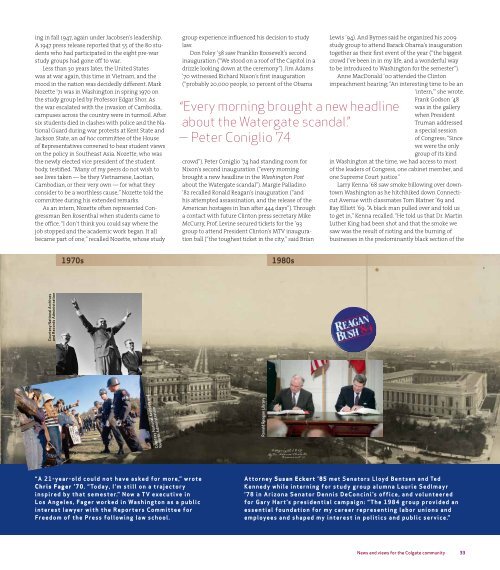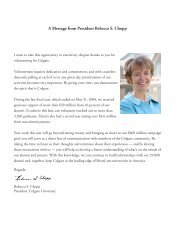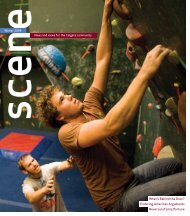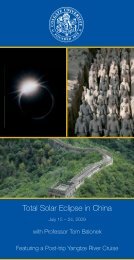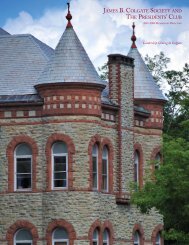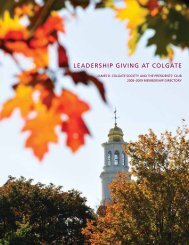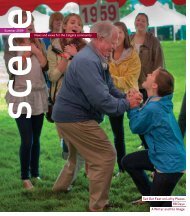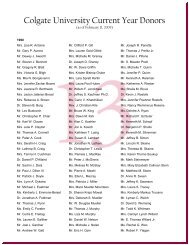101 Things To Do Before You Graduate Living In History ... - Alumni
101 Things To Do Before You Graduate Living In History ... - Alumni
101 Things To Do Before You Graduate Living In History ... - Alumni
Create successful ePaper yourself
Turn your PDF publications into a flip-book with our unique Google optimized e-Paper software.
ing in fall 1947, again under Jacobsen’s leadership.<br />
A 1947 press release reported that 55 of the 80 students<br />
who had participated in the eight pre-war<br />
study groups had gone off to war.<br />
Less than 30 years later, the United States<br />
was at war again, this time in Vietnam, and the<br />
mood in the nation was decidedly different. Mark<br />
Nozette ’71 was in Washington in spring 1970 on<br />
the study group led by Professor Edgar Shor. As<br />
the war escalated with the invasion of Cambodia,<br />
campuses across the country were in turmoil. After<br />
six students died in clashes with police and the National<br />
Guard during war protests at Kent State and<br />
Jackson State, an ad hoc committee of the House<br />
of Representatives convened to hear student views<br />
on the policy in Southeast Asia. Nozette, who was<br />
the newly elected vice president of the student<br />
body, testified. “Many of my peers do not wish to<br />
see lives taken — be they Vietnamese, Laotian,<br />
Cambodian, or their very own — for what they<br />
consider to be a worthless cause,” Nozette told the<br />
committee during his extended remarks.<br />
As an intern, Nozette often represented Congressman<br />
Ben Rosenthal when students came to<br />
the office. “I don’t think you could say where the<br />
job stopped and the academic work began. It all<br />
became part of one,” recalled Nozette, whose study<br />
Courtesy National Archives<br />
and Records Administration<br />
group experience influenced his decision to study<br />
law.<br />
<strong>Do</strong>n Foley ’38 saw Franklin Roosevelt’s second<br />
inauguration (“We stood on a roof of the Capitol in a<br />
drizzle looking down at the ceremony”). Jim Adams<br />
’70 witnessed Richard Nixon’s first inauguration<br />
(“probably 20,000 people, 10 percent of the Obama<br />
crowd”). Peter Coniglio ’74 had standing room for<br />
Nixon’s second inauguration (“every morning<br />
brought a new headline in the Washington Post<br />
about the Watergate scandal”). Margie Palladino<br />
’82 recalled Ronald Reagan’s inauguration (“and<br />
his attempted assassination, and the release of the<br />
American hostages in Iran after 444 days”). Through<br />
a contact with future Clinton press secretary Mike<br />
McCurry, Prof. Levine secured tickets for the ’93<br />
group to attend President Clinton’s MTV inauguration<br />
ball (“the toughest ticket in the city,” said Brian<br />
Lewis ’94). And Byrnes said he organized his 2009<br />
study group to attend Barack Obama’s inauguration<br />
together as their first event of the year (“the biggest<br />
crowd I’ve been in in my life, and a wonderful way<br />
to be introduced to Washington for the semester”).<br />
Anne Mac<strong>Do</strong>nald ’00 attended the Clinton<br />
impeachment hearing; “An interesting time to be an<br />
‘intern,’” she wrote.<br />
Frank Godson ’48<br />
“Every morning brought a new headline<br />
about the Watergate scandal.”<br />
— Peter Coniglio ’74<br />
1970s 1980s<br />
Courtesy National Archives and<br />
Records Administration<br />
“A 21-year-old could not have asked for more,” wrote<br />
Chris Fager ’70. “<strong>To</strong>day, I’m still on a trajectory<br />
inspired by that semester.” Now a TV executive in<br />
Los Angeles, Fager worked in Washington as a public<br />
interest lawyer with the Reporters Committee for<br />
Freedom of the Press following law school.<br />
Ronald Reagan Library<br />
was in the gallery<br />
when President<br />
Truman addressed<br />
a special session<br />
of Congress; “Since<br />
we were the only<br />
group of its kind<br />
in Washington at the time, we had access to most<br />
of the leaders of Congress, one cabinet member, and<br />
one Supreme Court justice.”<br />
Larry Kenna ’68 saw smoke billowing over downtown<br />
Washington as he hitchhiked down Connecticut<br />
Avenue with classmates <strong>To</strong>m Blatner ’69 and<br />
Ray Elliott ’69. “A black man pulled over and told us<br />
to get in,” Kenna recalled. “He told us that Dr. Martin<br />
Luther King had been shot and that the smoke we<br />
saw was the result of rioting and the burning of<br />
businesses in the predominantly black section of the<br />
Attorney Susan Eckert ’85 met Senators Lloyd Bentsen and Ted<br />
Kennedy while interning for study group alumna Laurie Sedlmayr<br />
’78 in Arizona Senator Dennis DeConcini’s office, and volunteered<br />
for Gary Hart’s presidential campaign: “The 1984 group provided an<br />
essential foundation for my career representing labor unions and<br />
employees and shaped my interest in politics and public service.”<br />
News and views for the Colgate community<br />
33


